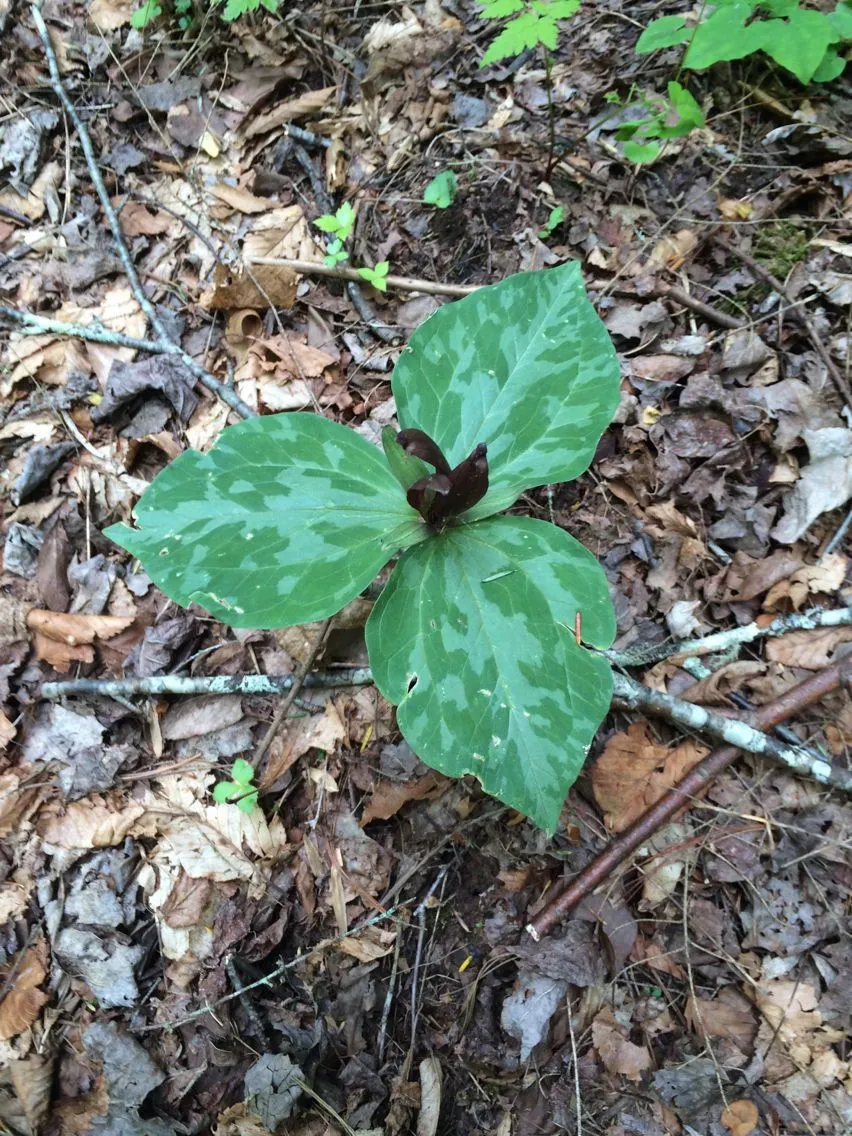
Author: Raf.
Bibliography: Autik. Bot.: 133 (1840)
Year: 1840
Status: accepted
Rank: species
Genus: Trillium
Vegetable: False
Observations: SE. U.S.A.
Little Sweet Betsy, known scientifically as Trillium cuneatum, is a captivating species belonging to the Melanthiaceae family. Described by renowned botanist Rafinesque in 1840, this perennial herbaceous plant is notable for its distinctive triangular flowers and broad, mottled leaves. Native to the southeastern regions of the United States, Little Sweet Betsy thrives in the rich woodland soils of this area, making it a true representative of SE U.S.A.’s diverse flora.
This plant typically blooms in early spring, producing flowers that range in color from maroon to greenish-brown, often with a striking fragrance that adds to its allure. The flowers, comprising three petals and three sepals, are perched atop a single stalk, ensuring they stand out against the backdrop of dense forest undergrowth. The leaves, usually patterned with shades of dark green and light grey, further enhance its visual appeal.
Despite its modest size, Little Sweet Betsy plays a crucial role in its native ecosystems. It is well-adapted to the shaded, moist environments of deciduous forests, where it contributes to the understory biodiversity. The plant’s propagation relies on ants for seed dispersal, a fascinating mutualistic relationship known as myrmecochory.
For gardeners and plant enthusiasts interested in cultivating Little Sweet Betsy, it requires a habitat that mimics its natural woodland environment. This entails providing ample shade, well-draining soil, and a canopy that protects against harsh sunlight. In the right conditions, Trillium cuneatum can be a charming addition to shaded garden areas, offering a touch of wilderness and beauty.
It is vital to note that while Little Sweet Betsy is not currently listed as endangered, habitat preservation is crucial to ensure its continued presence in the wild. Efforts to conserve its natural habitats will help maintain the delicate balance of the ecosystems it supports.
Eng: little sweet betsy, cuneate trillium, bloody butcher, large toadshade, little sweet trillium, purple toadshade, sweet betsy, whip-poor-will flower
En: Little sweet Betsy, Cuneate Trillium, Bloody Butcher, Large Toadshade, Little Sweet Trillium, Purple Toadshade, Sweet Betsy, Whip-poor-will Flower
: Little sweet betsy
© copyright of the Board of Trustees of the Royal Botanic Gardens, Kew.
© copyright of the Board of Trustees of the Royal Botanic Gardens, Kew.
© copyright of the Board of Trustees of the Royal Botanic Gardens, Kew.
Taken Apr 5, 2021 by Michael Niemeier (cc-by-sa)
Taken May 9, 2020 by Frank Frank Esposito (cc-by-sa)
Taken Apr 16, 2022 by Marie Gentile (cc-by-sa)
Taken May 12, 2019 by Dan K (cc-by-sa)
Taken Apr 3, 2022 by Holly Owen (cc-by-sa)
Taken May 30, 2015 by EOL − etool (cc-by-nc)
Taken Jun 7, 2009 by EOL − Katja Schulz (cc-by)
Taken Feb 24, 2016 by EOL − Kenric Minges (cc-by-nc)
Taken Feb 24, 2016 by EOL − Kenric Minges (cc-by-nc)
Taken Apr 2, 2016 by EOL − Carless Dance (cc-by-nc)
Taken Jan 1, 1900 by EOL − Derek Ramsey (Ram-Man) (cc-by-sa)
Taken Apr 13, 2019 by Steve Steve Bachtel (cc-by-sa)
Taken Apr 3, 2022 by Doug Todd (cc-by-sa)
Taken Apr 12, 2022 by Mary Lu Rogers (cc-by-sa)
Taken Apr 5, 2021 by Michael Niemeier (cc-by-sa)
Taken Apr 5, 2003 by EOL − Steven J. Baskauf (cc-by-nc-sa)
Growth habit>: Forb/herb
Family: Myrtaceae Author: (F.Muell.) K.D.Hill & L.A.S.Johnson Bibliography: Telopea 6: 402 (1995) Year: 1995 Status:…
Family: Rubiaceae Author: Pierre ex A.Froehner Bibliography: Notizbl. Bot. Gart. Berlin-Dahlem 1: 237 (1897) Year:…
Family: Sapindaceae Author: Koidz. Bibliography: J. Coll. Sci. Imp. Univ. Tokyo 32(1): 38 (1911) Year:…
Family: Asteraceae Author: A.Gray Bibliography: Pacif. Railr. Rep.: 107 (1857) Year: 1857 Status: accepted Rank:…
Family: Fabaceae Author: Medik. Bibliography: Vorles. Churpfälz. Phys.-Ökon. Ges. 2: 398 (1787) Year: 1787 Status:…
Family: Aspleniaceae Author: (Cav.) Alston Bibliography: Bull. Misc. Inform. Kew 1932: 309 (1932) Year: 1932…